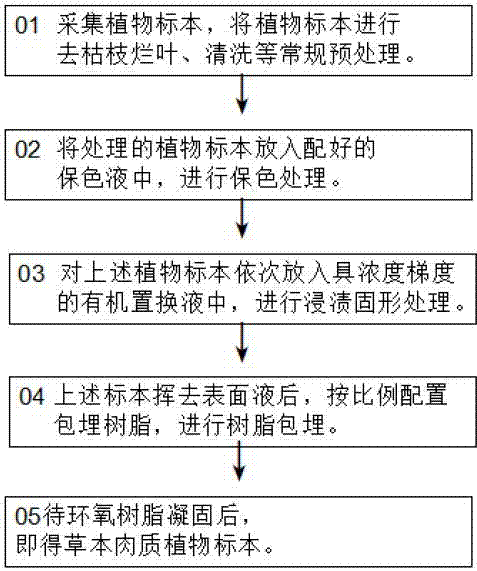Method for preparing resin-embedded succulent herb specimen
The technology of a herb and its production method is applied in the field of making succulent herb specimens, which can solve the problems of poor quality of succulent herb specimens and difficulty in preserving succulent herb plants, and achieve the effect of various sizes, realistic colors and high transparency
- Summary
- Abstract
- Description
- Claims
- Application Information
AI Technical Summary
Problems solved by technology
Method used
Image
Examples
example 1
[0032] The making of a resin-embedded blue stone lotus specimen comprises the following steps:
[0033] 1) Cleaning the Lachrysia chinensis plant, removing its dead branches and rotten leaves, subtracting redundant rhizomes, cleaning it with distilled water, and waiting for it to dry;
[0034] 2) Configure a color-preserving solution containing 2% of aluminum sulfate, pack the blue stone lotus plant in a non-woven bag and tie it tightly, and place it in it for 15 hours of immersion treatment;
[0035] 3) Take out the non-woven bag with tweezers, open the bag mouth, wash off the color retention liquid on the surface of the plant with distilled water, wait for it to air dry naturally or blow it dry with a fan, then put the non-woven bag into the organic replacement solution ;
[0036] 4) Put the blue stone lotus plant successively in 70% ethanol solution, 80% ethanol solution, 90% ethanol solution, 95% ethanol solution, absolute ethanol, absolute ethanol, 50% ethanol solution+5...
example 2
[0042] The making of a resin-embedded Jinhuangxing specimen comprises the following steps:
[0043] 1) Treat the Jinhuangxing plant, remove its dead branches and rotten leaves, remove excess rhizomes, use a brush to remove dust and impurities on the surface, and set aside;
[0044] 2) Configure a color-retaining solution containing 10% copper sulfate and 0.5% formalin, pack the Jinhuangxing plant in a non-woven bag and tie it tightly, and place it in it for 24 hours of immersion treatment;
[0045] 3) Take out the non-woven bag with tweezers, open the bag mouth, wash off the color retention liquid on the surface of the plant with distilled water, wait for it to air dry naturally or blow it dry with a fan, then put the non-woven bag into the organic replacement solution ;
[0046] 4) Put Jinhuangxing plants in 70% ethanol solution, 80% ethanol solution, 90% ethanol solution, 95% ethanol solution, absolute ethanol, absolute ethanol, 50% ethanol solution+50% xylene solution, 25%...
example 3
[0051] The making of a resin-embedded Ji Qiuli specimen comprises the following steps:
[0052] 1) Clean Ji Qiuli plant, remove its dead branches and rotten leaves, remove redundant rhizomes, clean it with distilled water, and wait for it to dry;
[0053] 2) Prepare a color-retaining solution containing 0.15% to 0.5% sulfurous acid, pack the Jiqiuli plant in a non-woven bag and tie it tightly, and place it there for 20 hours of immersion treatment;
[0054] 3) Take out the non-woven bag with tweezers, open the bag mouth, wash off the color retention liquid on the surface of the plant with distilled water, wait for it to air dry naturally or blow it dry with a fan, then put the non-woven bag into the organic replacement solution ;
[0055] 4) Ji Qiuli plant is successively in 70% ethanol solution, 80% ethanol solution, 90% ethanol solution, 95% ethanol solution, absolute ethanol, absolute ethanol, 50% ethanol solution+50% xylene solution, 25% ethanol solution +75% xylene solu...
PUM
 Login to View More
Login to View More Abstract
Description
Claims
Application Information
 Login to View More
Login to View More - R&D
- Intellectual Property
- Life Sciences
- Materials
- Tech Scout
- Unparalleled Data Quality
- Higher Quality Content
- 60% Fewer Hallucinations
Browse by: Latest US Patents, China's latest patents, Technical Efficacy Thesaurus, Application Domain, Technology Topic, Popular Technical Reports.
© 2025 PatSnap. All rights reserved.Legal|Privacy policy|Modern Slavery Act Transparency Statement|Sitemap|About US| Contact US: help@patsnap.com

